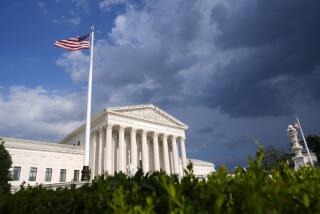Cites ‘Avalanche’ of Cases Faced by Justices : Burger Urges Panel to Ease Court’s Job
WASHINGTON — Chief Justice Warren E. Burger, citing an “avalanche” of cases before the Supreme Court, called again Sunday for a new national panel of judges that could rule on up to one-third of the cases currently being decided by the court.
Urging action on a proposal that has been debated for more than a dozen years, Burger declared:
“Why is it so difficult to grasp the reality that just as we need more police and more courts to deal with automobile traffic than we did 75 years ago . . . we need something more to deal with the avalanche of cases coming to the Supreme Court?”
Burger’s remarks were contained in a speech at the mid-year meeting of the American Bar Assn. in Detroit. A text was issued in Washington.
Proposals Stall in Congress
Proposals for creation of some kind of intermediate appeals court to ease the Supreme Court’s burden have made little headway in Congress. Critics have called the proposals costly, burdensome and unnecessary--contending that the justices, for the most part, can control their own workload by limiting the number of cases they agree to decide.
Burger devoted his entire 10-page annual report to the ABA to explaining his proposal for a new court and trying to refute its critics. Under the plan, the high court would create a special panel of nine federal appellate judges, then assign to it cases that involve conflicting rulings among the nation’s 13 separate U.S. Circuit Courts of Appeal. The panel’s decisions could be appealed to the Supreme Court--but Burger predicted few would warrant formal review.
Burger said the panel’s burden on the taxpayers would be minimal, involving only the costs of sending nine judges to Washington for perhaps two two-week sessions a year. Existing judicial staffs could absorb the additional administrative duties of a new court, he said.
The panel would be “temporary and experimental,” the chief justice emphasized, and could be terminated even before its five-year limitation.
Increased Caseload
Burger noted that the Supreme Court’s overall caseload had more than tripled since Chief Justice Earl Warren took office in 1953. More importantly, the number of “signed opinions”--the cases in which the court hears arguments and renders written opinions--increased from 65 in Warren’s first term to a current rate of about 150 a year, Burger pointed out. In the last three terms, the court has decided an average of 48 cases involving conflicting rulings among federal appeals courts, he said.
If the proposed panel took “30 to 50” cases away from the court, “that would obviously be of help,” he said, enabling the justices to maintain “the high quality the public has a right to expect.”
The chief justice observed that with recent expansions in the size of the nation’s judiciary, there now are nearly 1,000 federal circuit and district judgeships--about a quarter of them senior judges on part-time status--and about 27,000 state court judges. “All those judges are deciding cases potentially subject to Supreme Court review,” he said. “And there are still nine justices on the Supreme Court.”
Burger recalled an opinion written in 1959 by Justice Felix Frankfurter, citing the justices’ collective need for sufficient time for reflection and discussion in order to produce “thoughtful, unhurried decisions . . . and learned and impressive opinions.”
The rest of the federal judiciary also would benefit through the panel’s prompt resolution of recurring conflicts, Burger said. He noted, for example, that there have been seven federal appellate court rulings and 20 District Court decisions in recent years on the sole question of whether the U.S. Post Office is immune from state garnishment proceedings.
More to Read
Get the L.A. Times Politics newsletter
Deeply reported insights into legislation, politics and policy from Sacramento, Washington and beyond. In your inbox three times per week.
You may occasionally receive promotional content from the Los Angeles Times.










